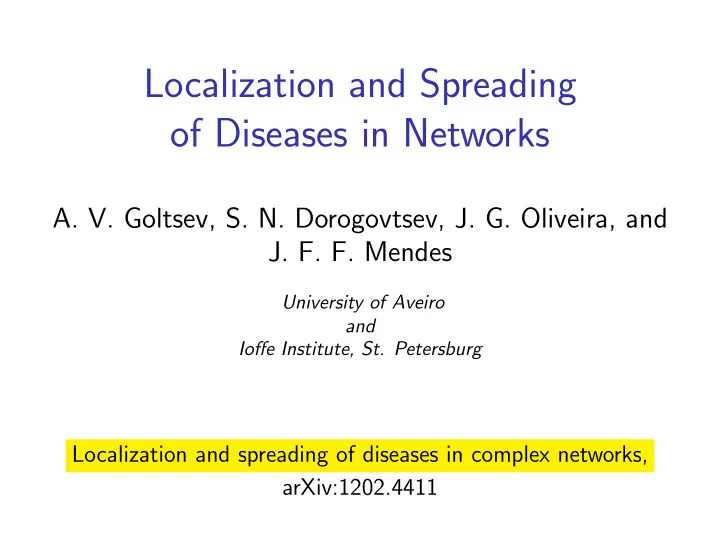

Localization and Spreading of Diseases in Networks A. V. Goltsev, S. N. Dorogovtsev, J. G. Oliveira, and J. F. F. Mendes University of Aveiro and Ioffe Institute, St. Petersburg Localization and spreading of diseases in complex networks, arXiv:1202.4411
www2012: Tim Berners-Lee: “A Google search shows you the eigenvectors of society”. More correctly: it shows you only the principal vector of society. → “mostly” (arXiv:1202.4411) 2 / 37
The standard SIS model: Infected vertices become susceptible with unit rate: 1 → S , I and each susceptible vertex becomes infected by its infective neighbour with the infection rate λ : λ → I . S ⇑ I nn (arXiv:1202.4411) 3 / 37
Seminal papers: Pastor-Satorras and Vespignani (2001): λ c = � q � / � q 2 � . If � q 2 � → ∞ , then λ c = 0. If � q 2 � < ∞ , then λ c > 0. :( λ c = � q � / ( � q 2 �−� q � ). ] [ For the SIR model, (arXiv:1202.4411) 4 / 37
Their approximations: (1) Correlations between infectives and susceptibles were neglected. (2) A random graph is substituded with its annealed counterpart !!! (3) N → ∞ . (arXiv:1202.4411) 5 / 37
Without approximation 2, for an individual graph: Y. Wang, D. Chakrabarti, C. Wang, and C. Faloutsos (2003): λ c = 1 / Λ 1 Λ 1 is the eigenvalue of the principal eigenvector of the adjacency matrix. Λ 1 ∼ √ q max , q max ( N → ∞ ) → ∞ for the ER graphs, and so λ c ( N → ∞ ) → 0 . (arXiv:1202.4411) 6 / 37
SIS: the transition is not thermodynamic The Ising model, percolation: a thermodynamic phase transition — it exists only if N → ∞ . Sync, neural networks, the SIS model: a sharp transition is even in finite systems, even for two pendulums. (arXiv:1202.4411) 7 / 37
The SIS on an individual graph, (but not on a statistical ensemble!) The evolution equation: N � d ρ i ( t ) = − ρ i ( t ) + λ [1 − ρ i ( t )] A ij ρ j ( t ) . dt j =1 The steady state: λ � j A ij ρ j 1 + λ � ρ i = . j A ij ρ j (arXiv:1202.4411) 8 / 37
� ρ i = c (Λ) f i (Λ) . Λ N � � f i (Λ) f i (Λ ′ ) Λ ′ c (Λ ′ ) c (Λ) = λ . 1 + λ � Λ � Λ c ( � Λ) f i ( � Λ) � Λ ′ i =1 If τ ≡ λ Λ 1 − 1 ≪ 1, then N � ρ ≡ ρ i / N ≈ α 1 τ, i =1 N N � � f 3 α 1 = [ f i (Λ 1 )] / [ N i (Λ 1 )] . i =1 i =1 (arXiv:1202.4411) 9 / 37
Localized and delocalized eigenvectors: � N i f 2 Normalization: i (Λ) = 1 The inverse participation ratio: N � f 4 IPR (Λ) ≡ i (Λ) . i =1 N →∞ A localized state: IPR (Λ) → 0. N →∞ A delocalized state: IPR (Λ) → const . It depends on a particular network realization. (arXiv:1202.4411) 10 / 37
√ A delocalized principal eigenvector: f i (Λ) = O (1 / N ), so α 1 = O (1) A localized principal eigenvector: α 1 = O (1 / N ) — the disease is localized on a finite number of vertices in contrast to “localization” within k -cores (a finite fraction of vertices), see Kitsak (2010), Castellano and Pastor-Satorras (2012). (arXiv:1202.4411) 11 / 37
Unweighted networks: The first iteration ( g (0) =1): � q i A ij q j = Λ MF + � q � σ 2 r 1 Λ (1) = � q 2 � , 1 � q 2 � N i , j IPR MF = � q 4 � / [ N � q 2 � 2 ] ∼ O (1 / N ) where r is the Pearson coefficient, Λ MF ≡� q 2 � / � q � . So assortative degree–degree correlations increase Λ 1 and decrease λ c . (arXiv:1202.4411) 12 / 37
Weighted and unweighted real-world nets: (a) astro-phys (upper) and cond-mat-2005 (lower) weighted networks. (b) Karate-club network (unweighted). The lower curve accounts for only the eigenstate Λ 1 . The most upper curve is the “exact” ρ . (arXiv:1202.4411) 13 / 37
An uncorrelated scale-free net: A scale-free network of 10 5 vertices generated by the static model with γ = 4, � q � = 10. (b) Zoom of the prevalence at λ near λ c = 1 / Λ 1 . I, II eigenvectors are localized, III is delocalized. (arXiv:1202.4411) 14 / 37
A Bethe lattice with a hub: Find Λ 1 if B = k − 1 is the branching and then B substitute with � B � . The localization of the principal eigenvector at a hub with q max occurs if � Λ 1 = q max / q max − B ≥ Λ d > ≈ Λ MF (arXiv:1202.4411) 15 / 37
Conclusion If the principal eigenvector is localized, then right above the threshold 1 / Λ 1 , the disease is localized on a finite number of vertices. In this case, a real epidemic affecting a finite fraction of vertices occurs after a smooth crossover, and the notion of the epidemic threshold is meaningless. (arXiv:1202.4411) 16 / 37
Lectures on Complex Networks (arXiv:1202.4411) 17 / 37
Recommend
More recommend